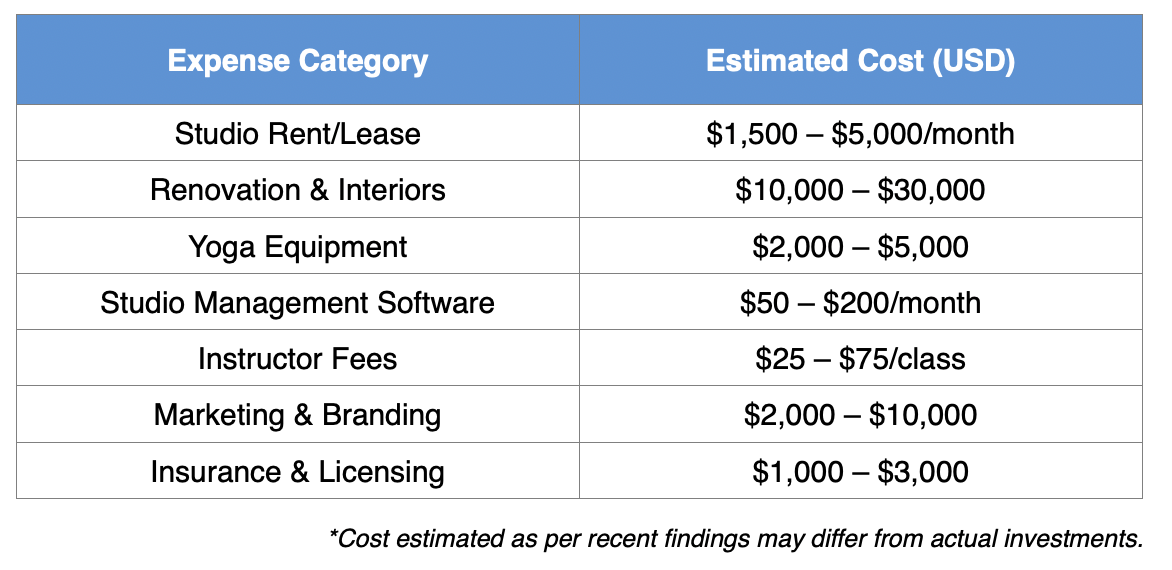
Opening a yoga studio is a fulfilling dream — a place where you help others find balance while living your passion. But behind the calm and serenity of a yoga class lies a business that thrives on careful financial planning.
.jpg)
Opening a yoga studio is a fulfilling dream — a place where you help others find balance while living your passion. But behind the calm and serenity of a yoga class lies a business that thrives on careful financial planning.
If you’ve ever wondered how to open a yoga studio successfully, it all starts with one powerful skill — budgeting. Proper budgeting keeps your business stable, ensures sustainable growth, and allows you to focus on what you love most: teaching yoga and creating a mindful community.
In this blog, we’ll explore why budgeting is essential for your yoga studio and share 7 practical financial tips to help you launch and manage your studio like a pro.
When you start researching how to open a yoga studio, finances might not seem as exciting as designing your space or planning your classes. But budgeting is what turns your idea into a successful, lasting business.
A well-planned budget helps you:
Budgeting gives your yoga studio the structure it needs to thrive — just like a strong foundation in your practice gives you balance on the mat.
Before setting up your studio, it’s crucial to know what you’re financially committing to. Costs can vary depending on your location, studio size, and offerings, but here’s a general breakdown of what to expect when learning how to open a yoga studio:

Understanding these costs early helps you set realistic financial goals, avoid surprises, and prepare for a smoother launch.
Now that you know the importance of budgeting, let’s dive into seven actionable financial tips that every aspiring yoga studio owner should follow.
A yoga studio business plan is your blueprint for success. It outlines your goals, strategies, expenses, and potential profits. Your plan should include:
Having a solid business plan not only helps you stay organized but also increases your chances of securing loans or investors.
When figuring out how to open a yoga studio, many entrepreneurs underestimate costs. You’ll need to consider both fixed costs (rent, utilities, software subscriptions) and variable costs (marketing, events, class materials).
Set aside an emergency fund for unexpected expenses like repairs or slow months. A three-month financial cushion ensures your studio stays stable through any challenge.
Cash flow management is key to long-term success. Even if your studio is popular, poor cash handling can cause trouble.
Track income from class packages, memberships, workshops, and online sessions. Use yoga studio software like StudioBookings to automate billing, monitor attendance, and generate reports.
This will help you see where your money is coming from — and where it’s going — at a glance.
When opening a yoga studio, you might feel tempted to splurge on luxurious furniture or designer décor. But smart budgeting means focusing on what truly enhances the client experience — quality mats, comfortable props, calming lights, and certified instructors.
Start lean. As your revenue grows, you can upgrade equipment and interiors gradually. This approach helps you build a solid foundation without financial strain.
Depending solely on class memberships is risky. To maintain steady revenue, diversify your offerings:
Multiple income streams make your studio more resilient and profitable — even during low seasons.
Technology can transform how you run your yoga studio. Using fitness studio management software simplifies billing, class scheduling, membership renewals, and financial tracking.
Modern tools can also generate insights about client preferences and revenue trends. This data-driven approach helps you make informed business decisions and reduce human error. Having tools that at your studio such as https://inbodyusa.com/ smart body composition scale that members can use to check weight and body fat percentage etc can also drive member engagements.
Budgeting isn’t a one-time setup. Once your yoga studio is running, review your budget every quarter.
Ask yourself:
Small adjustments — like offering limited-time promotions or tweaking your class schedule — can make a big difference in your bottom line.
Let’s put this into perspective.
Imagine you invest $25,000 to open Serenity Yoga Studio. Your budget includes $10,000 for setup, $5,000 for marketing, and $3,000 for props. You also reserve $7,000 for operational expenses.
After three months, you notice an increase in demand for virtual classes. You invest a small amount in online teaching tools and attract a nationwide audience. Within six months, your studio reaches profitability — all thanks to mindful budgeting and strategic reinvestment.
Just as yoga teaches mindfulness, apply the same principle to your finances. A mindful approach to budgeting doesn’t limit you — it empowers you. By staying organized and intentional with your spending, you create room for creativity and growth. Financial wellness supports your studio’s spiritual wellness.
Learning how to open a yoga studio isn’t just about passion — it’s about planning. Budgeting helps you make smart decisions, prepare for challenges, and ensure your business thrives long-term.
With the right mix of financial discipline, smart technology, and creative vision, you can transform your dream studio into a sustainable business. Start small, stay mindful, and keep balancing your books — just like your favorite pose on the mat.